Driving past the abandoned colonial houses that once housed British administrators, you notice that you can see the road through a foot wide hole in the rusted out bottom of the 20 year old Toyota Corolla you have hired as a taxi. You pull up to the hill in the centre of town that draws pilgrims from all over the Buddhist world and give the driver the three Kyat you agreed at the journey’s start. Getting out of the car, there is only one thing that commands the skyline. A massive golden zedi (stupa) that is without doubt one of the most spectacular things created by humans. Hailing you to the southern of four directional entrances are a pair of enormous chinthe (mythical lion creatures).

You walk past them anticlockwise and ascend the covered steps on the eastern side as shopkeepers sleepily prepare their wares for the day. Mala beads and statues are placed outside of the small shop fronts that line both sides of the zaungdan (stairway). A legendary crocodile named Nga Moe Yeik acts as the ceremonial railing to the stairs near the top and lets you know that the temple is guarded by more than just government security. As you step out into the light of the sun at the top platform, the massive central zedi twinkles and golden Buddha statues shine in the shade of the countless shrines surrounding it. There is no photo, guidebook or story that can prepare you for the glory of the great pagoda of Yangon, the Shwedagon Zedi Daw.
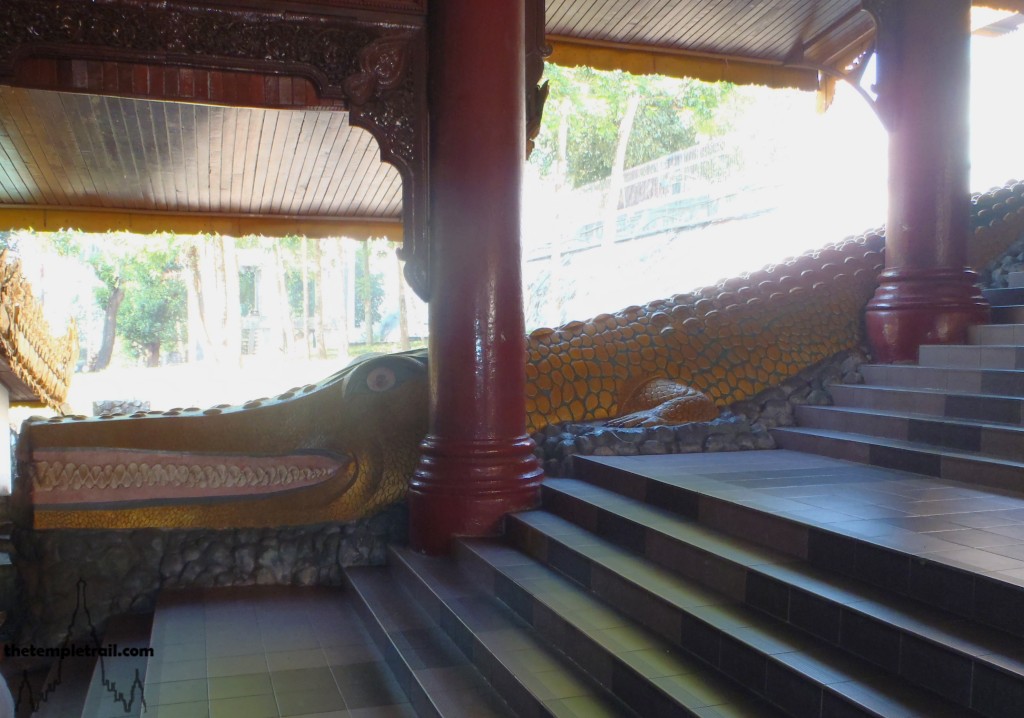
There has been a pagoda at this spot for more than two and a half thousand years, since the time of the historical Buddha. The story goes that two brothers called Tupassa and Bhallika, Mon merchants from Lower Burma, were the first two people to meet Siddhartha Gautama after he became the Buddha. They became the first converts and he gave them eight hairs that they brought back to the King of Okkalapa (Yangon). A local Nat (spirit) called Sularata (Sule Nat) helped them find Singuttara Hill, where relics of previous Buddhas had been buried, along with his fellow ancients; Yohani Nat and Dekkhina Nat. Sakka, the king of the Nats, wanted to help the king, but he was only 36 million years old; not old enough to remember the exact place on the hill that was visited by the earlier Buddhas. He asked the help of Sularata, the oldest Nat who, eager to earn merit to make up for trying to eat one of the earlier Buddhas, showed them the place the relics were buried. Here they enshrined the eight hairs and built the first zedi in the history of Buddhism. The spot that Sularata lived is marked by the small, but pretty Sulepaya in central Yangon. Archaeologically, the zedi can be traced back to the 6th century and the Mon people, but the Burmese strongly believe the story of the two brothers and who would deny them it. The zedi has been through earthquakes, fires, invasions and plundering by colonial powers. It has been mangled, maimed, renovated and rebuilt a number of times, including once by King Ashoka of India. The current incarnation of the outer-shell is from the 18th century by King Hsinbyushin of the Konbaung Dynasty who built it to its current height of 99 metres.
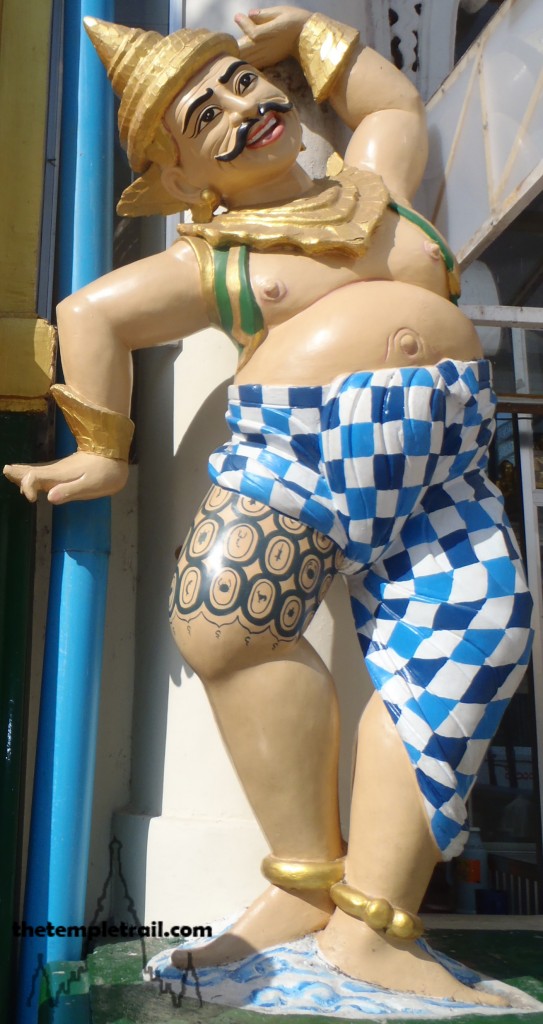
Heading straight ahead from the stairway, the first building you come to is the Eastern Directional Shrine that houses the Kakusandha Buddha, the first of the Buddhas of the current kalpa (time period – ‘fortunate aeon’) and the first of the three previous Buddhas to visit the hill. Outside his shrine you can buy some sheets of gold leaf to rub onto his golden statue with its upward turned palm. This is the first of the four main directional shrines. The southern shrine is for Konagamana, the west for Kassapa and the north for Gautama; these represent, in order, the Buddhas of the current kalpa and thereby the order in which they visited Singuttara Hill. The statue of Kakusandha (known as the Latpatlat or upturned hand Buddha image) is considered to be one of the nine wonders of the Shwedagon. Immediately behind the shrine and on the upper platform nearer the zedi is a niche that holds another wonder, the Tawagu Buddha statue. This is known as the Live Ruby Eyed Buddha and is, unfortunately only accessible to male Burmese nationals. Foreigners and particularly tourists are not allowed to visit it.
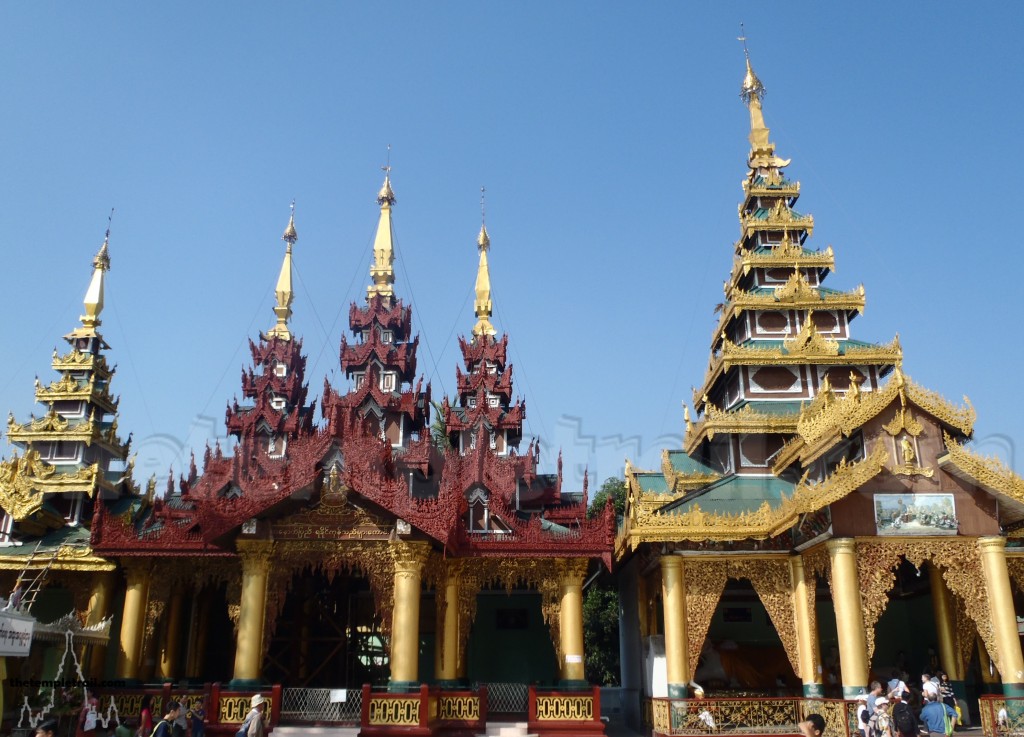
After leaving the shade of Kakusandha’s shrine, you walk clockwise to the south. On your left is the beautifully decorated U Nyo Tazaung (U Nyo shrine hall) and in front of the main zedi is a series of shrines for the deities that govern the days and the planetary posts. Here you will find adherents giving offerings to the nagas or elephants who correspond to their day of birth. If you go towards the station for Tuesday, you will find another wonder of Shwedagon; the Pyadashin Buddha (Live Mercury Buddha) that is believed to have a philosopher’s stone in its head. Walking past the southern shrine for Konagamana, you come to a cluster of buildings in the southwestern corner; notably the Hall of Gold and Silver Hills, the Chinese Merited Association Tazaung (with its statues of all 28 Buddhas) and the Shrine of the Sun and the Moon. In this corner of the terrace you come face-to-face with the guardian spirit of the Shwedagon, Bo Bo Gyi, in his glass enclosure. Also in the southwest corner, you can pray alongside the spirits, nats and belu demons at the Weizzar Zawgyi Pagoda: Pagoda of Wizards and Alchemists. The ornately decorated, yet pocket-sized pagoda is presided over by magical beings and is one of the nine wonders of Shwedagon. If you are looking for some supernatural help, it is the place to visit as it is fabled to have been built by magic as well as being the nat’s place of worship.
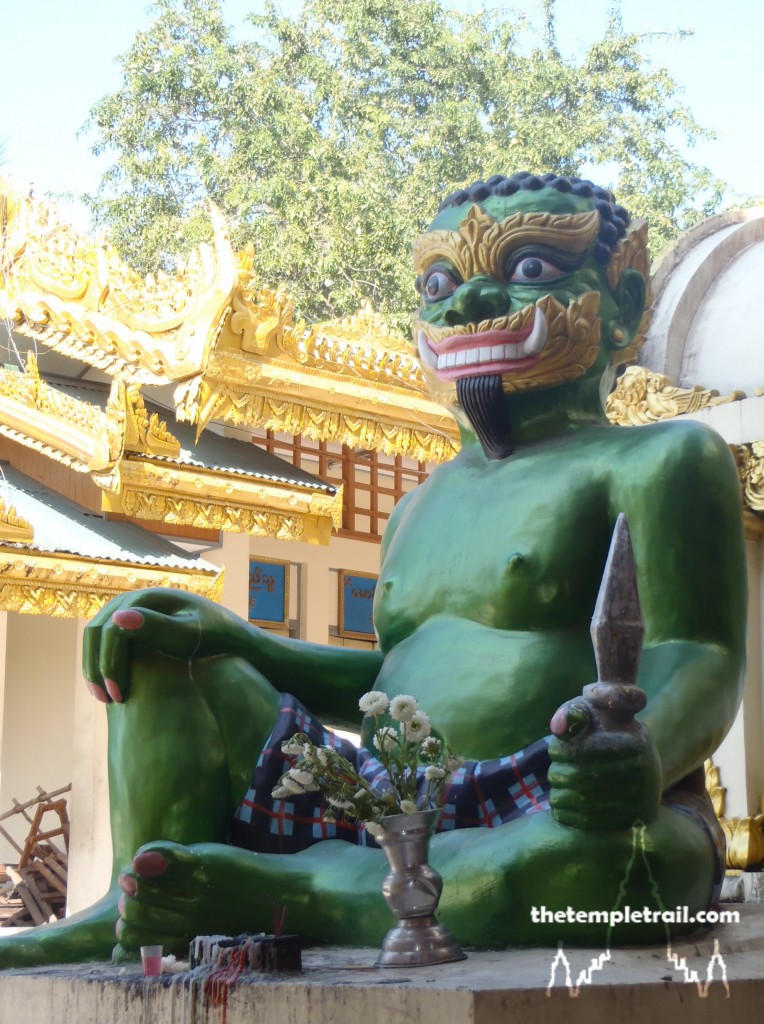
The tiered roof of the Rakhine Tazaung has beautifully carved panels depicting Jataka tales (stories of Buddha’s previous lives). Next to it is the Daw Pwint Tazaung that honours two nats who were executed by the King of Bagan for getting drunk while constructing a pagoda there. Directly opposite are two statues under umbrellas representing the parents of King Okkalapa, the builder of Shwedagon. Continuing your clockwise circumambulation, you come to the western shrine of Kassapa, the third Buddha and one step closer to Sakyamuni, the historical Buddha. The shrine’s neighbour, a statue of King Okkalapa himself, looks out on his creation as it stands today; very different from the humble beginnings it came from.
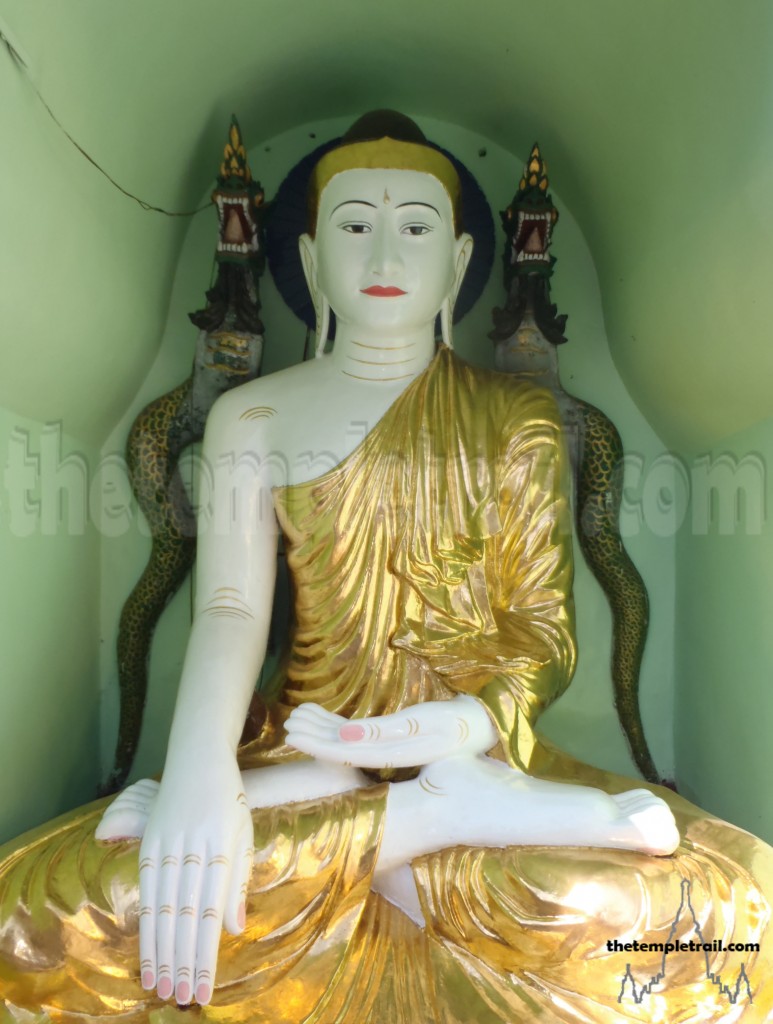
Staying on your trajectory, you continue to the northwestern corner. Here you find the small Pagoda of the Eight Weekdays (the Burmese consider Wednesday as two days). It is an octagonal stupa that has eight niches, each containing a Buddha with the animal that governs the day of the week above their heads. Located here are two highlights of Shwedagon. The first is the Maha Gandha Bell. The huge bell is more than two metres high, two metres wide and weighs 25 tons. It was given to the temple in 1779 by King Singu. The British tried to move the bell and it sank into the Yangon River as they were taking it across. They tried several times to salvage it, but could not. Eventually a group of Burmese people recovered it and it came back to Shwedagon. After walking through a shrine containing another of the nine wonders called the Shin Saw Pu Buddha, you come to the Hall of Great Prosperity. In this large building, there is a colossal seated Buddha. Here you can earn merit by fanning him with an old Burmese punka (fan attached to the ceiling and operated with a rope).
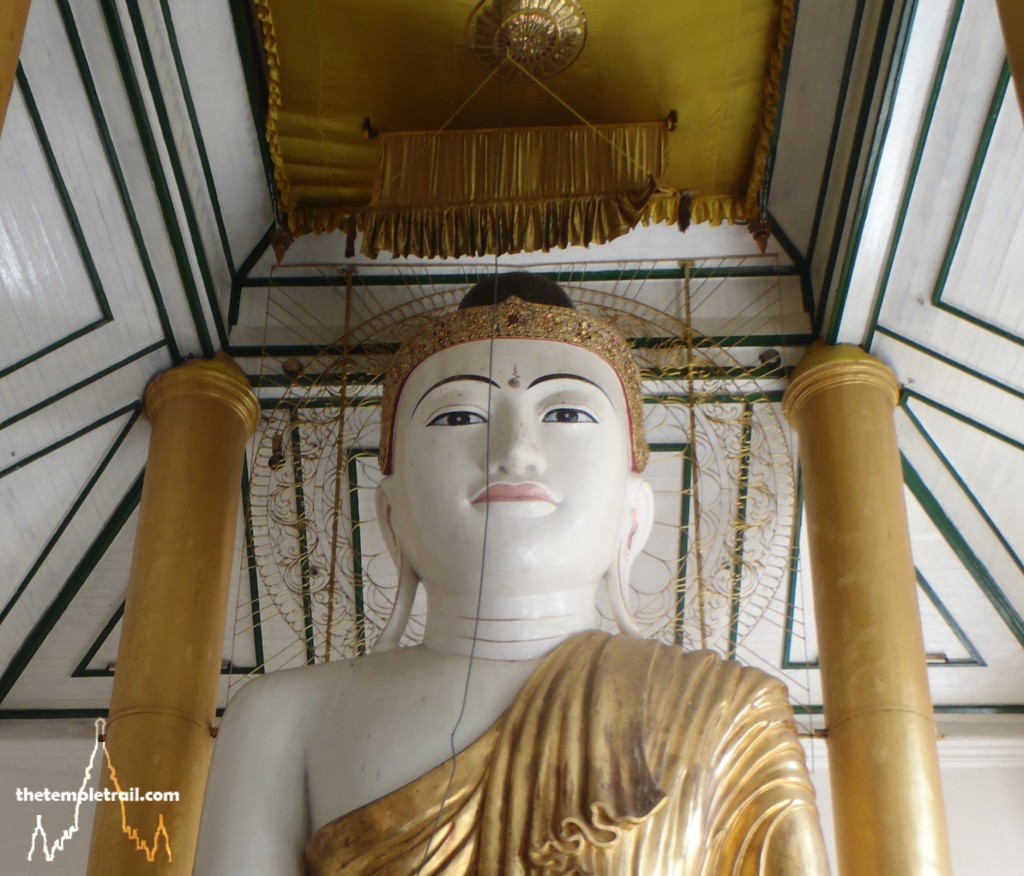
Behind the buildings and away from the domineering golden zedi are two Bodhi trees. In this area, there is a cool aura and you can take a moment to rest from the crowds circulating through the spired halls and reflect on how this tree’s shade gave Buddha shelter as he gained enlightenment. After your brief rest, you head back into the heat and energy of the main platform area. Here, there are some impossibly tall palm trees that seem like a snake charmer’s cobras reaching for the clouds. Like a rope into the heavens.
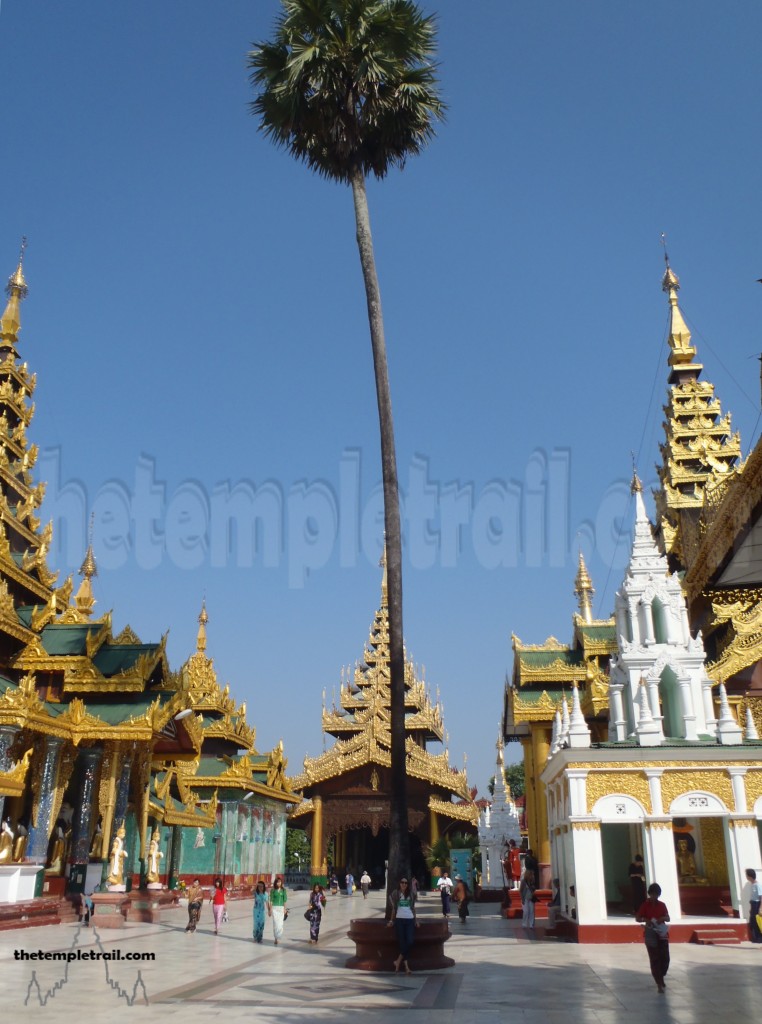
You are now squarely in the northern sector of the temple. This is the area that has the highest concentration of shrines, buildings and worshippers. This area is centred around the northern directional shrine to Siddhartha Gautama, Sakyamuni, Tathagata – the historical Buddha. One of the most sacred places in the temple is here; a flat area called the Victory Ground. Crowded with believers, it is the place where the kings of old would come to pray for victory in battle. It faces the eleven-shrine cluster that houses various Buddha images. Behind it is a beautiful hall called Chan Mah Phee’s Hall that has a wonderful tiered and spired roof that is adorned with nats and royal court figures. Abutting the hall is the Buddha Footprint hall that contains exactly what you think it would. The Buddha footprint is encircled by Mucalinda (the naga king who protected the Buddha while he was meditating) and sits in front of a majestic Buddha image.
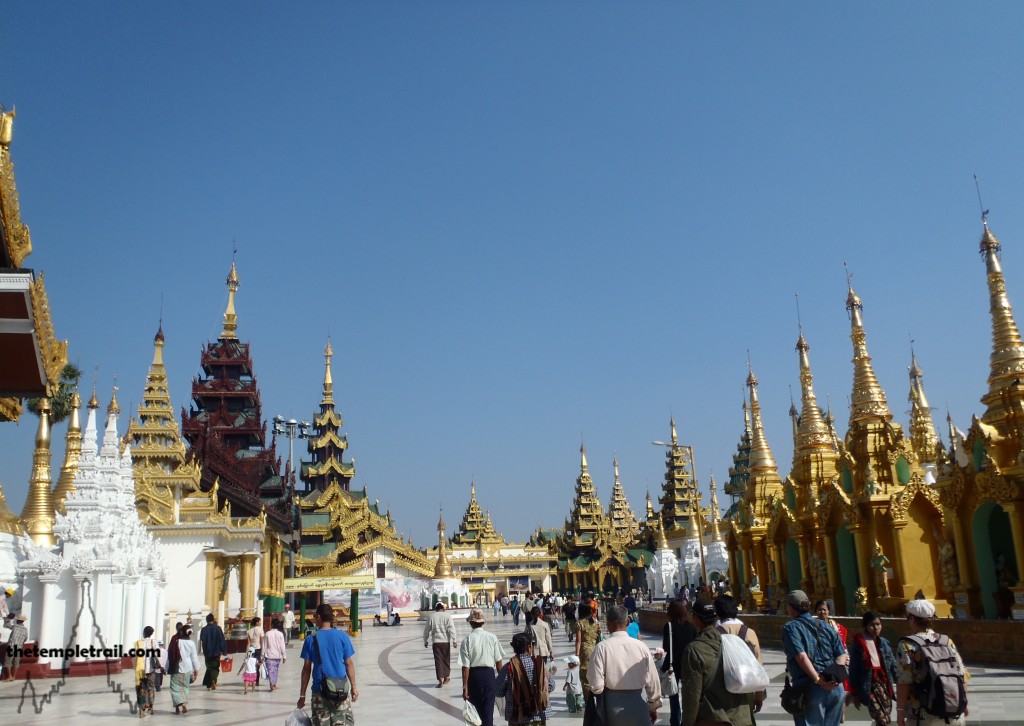
The Sandawdwin Pagoda covers a well that the Buddha hairs were washed in prior to being placed in the Shwedagon. A green and silver glass decorated brick shrine covers the spring that supposedly feeds from the Irrawaddy. It is protected by nagas and is beautifully inlaid. The Hall of Hair Washing, as it is also known, has the story of the two brothers illustrated on the screen carvings inside. It is yet another wonder of the Shwedagon. You then come to the northern directional shrine for Siddhartha Gautama, but you keep wandering around and the next thing you come to is a faithful miniature version of the Mahabodhi Temple in Bodhgaya. This is the first structure of the northeastern cluster. North of the Mahabodhi is the Hall of the Bodaw (wizards). The two door guardians are the Iron Bodaw and the Incantation Bodaw. This Nat shrine is devoted to the alchemists and wizards who strive for superhuman powers and immortality.
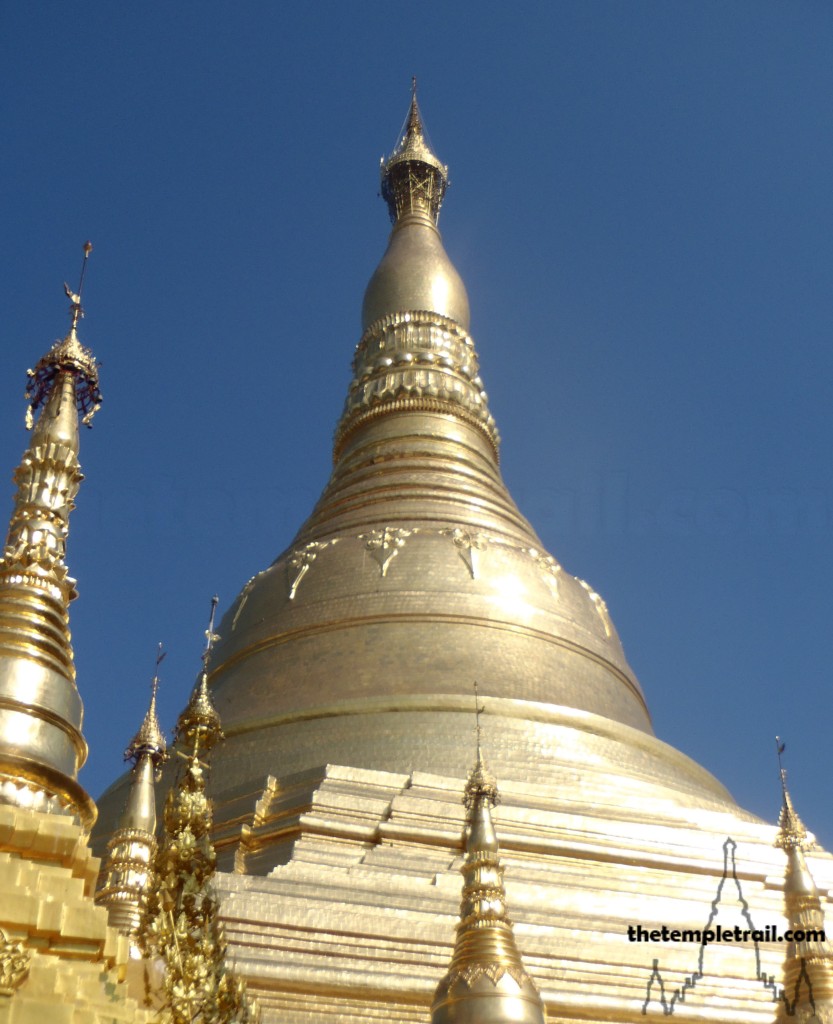
Continuing round on the edge of the platform, you begin your circling of the Naungdawgyi Paya (elder brother pagoda). This is a smaller gilded zedi. It is the second largest zedi on the terrace after the Shwedagon. The pagoda marks the spot that the hairs were placed when they first came to the hill. In the northern prayer hall of the pagoda is another of the nine wonders, the Shin Ma Hti Buddha. On your trip around this small pagoda, you can see the stones inscribed by King Dhammazedi in the far corner and then you come to the Shin Ajagona Tazaung, one of the nine wonders. The hall is devoted to a famous alchemist monk who tried to create Dat Lone (the philosopher’s stone) and failed. As a penance he tore out his eyes and threw the stone into the cesspit. When the stone came into contact with the faeces, it suddenly became the powerful metal he wanted. He replaced his eyes with a bull’s eye and a goat’s eye and so his name changed from Itzagawna to Ajagona (Ram-Bull). His statue has different sized eyes that illustrate this story.
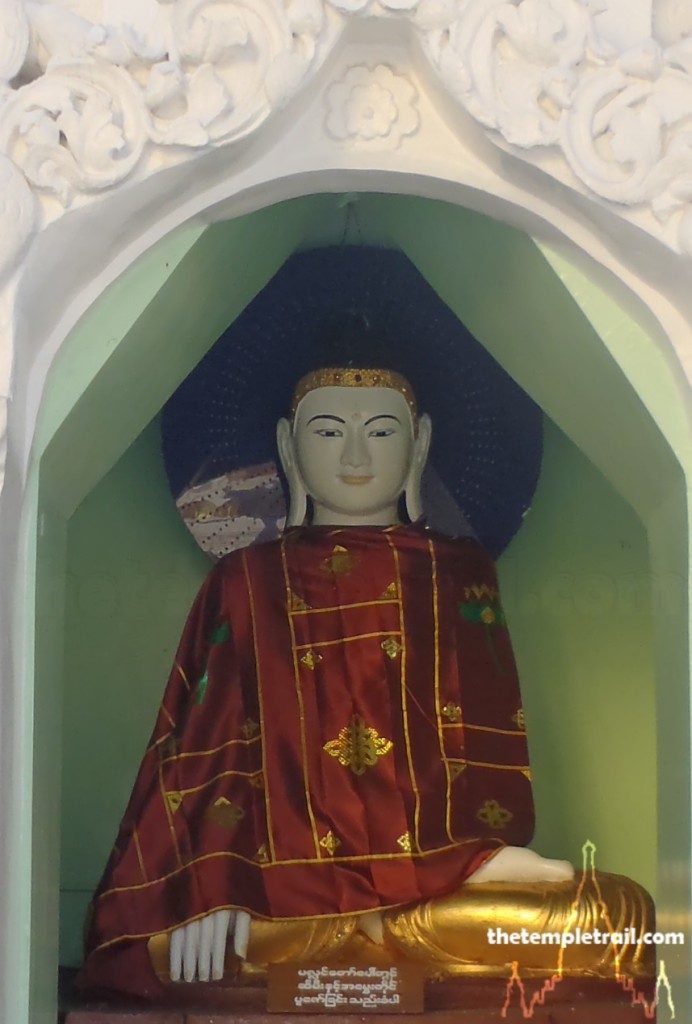
In the neighbouring Two Pice Hall, there is a magic stone in front of the Buddha image. When lifting the stone you should say; ‘May this stone seem light to me if my wish is to be fulfilled’. If it is light, then your wish will come true. Moving southeastward you come to the Mahatisaddaghanta bell (bell of the three sounds). The huge bell is the second biggest in Myanmar and weighs an impressive 42 tons. Next is the Bo Bo Aung Shrine. He was a famous bodaw from the 19th century who the Burmese believe is still alive now due to his magical immortality and built the shrine himself with his supernatural powers. The shrine is the last of the nine wonders on your tour of the platform. The final building before you end up back at the eastern stairway is the Daw Ngwe Zin Tazaung. The hall is a stand out for its Buddha images and particularly the crowned Labhamuni Buddha image. In this hall is a one and a half metre tall sandstone cylinder with 365 seated Buddhas carved onto it.
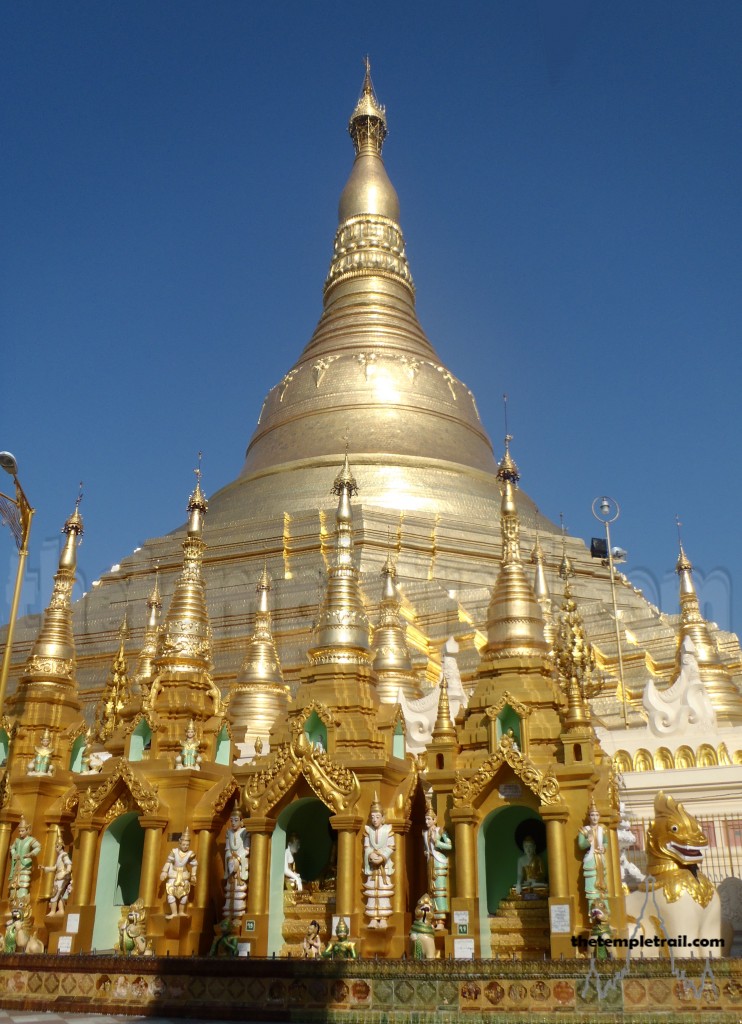
Having completed your full circle of the platform your head is reeling from the sheer number of temple buildings, images and stories. One thing that has stayed with you for your whole journey is the massive towering golden zedi. Quite simply, it is heart-stoppingly beautiful. Gold fills your vision. It is too much to see in one glance. The plinth that it sits on is six and a half metres tall and has 64 small stupas surrounding the main one. The main zedi has octagonal paccaya (terraces) that only men can access, followed by the shit-mhaung (octagonal dias), topped by the khaung laung (bell-shaped part). Next up is the turban and an upturned alms bowl that transitions into lotus petals. They smoothly meld into the banana bud. The banana bud section is topped by the hti (umbrella) that is the tapering end of the spire and has 1065 golden bells suspended from it. At the very pinnacle of the zedi, 99 metres in the sky, is the diamond bud. You cannot see it from ground level, but a photo shows you the ball is adorned with 5448 diamonds, 2317 rubies and sapphires and, at the very top, is crowned with a 76 carat diamond.
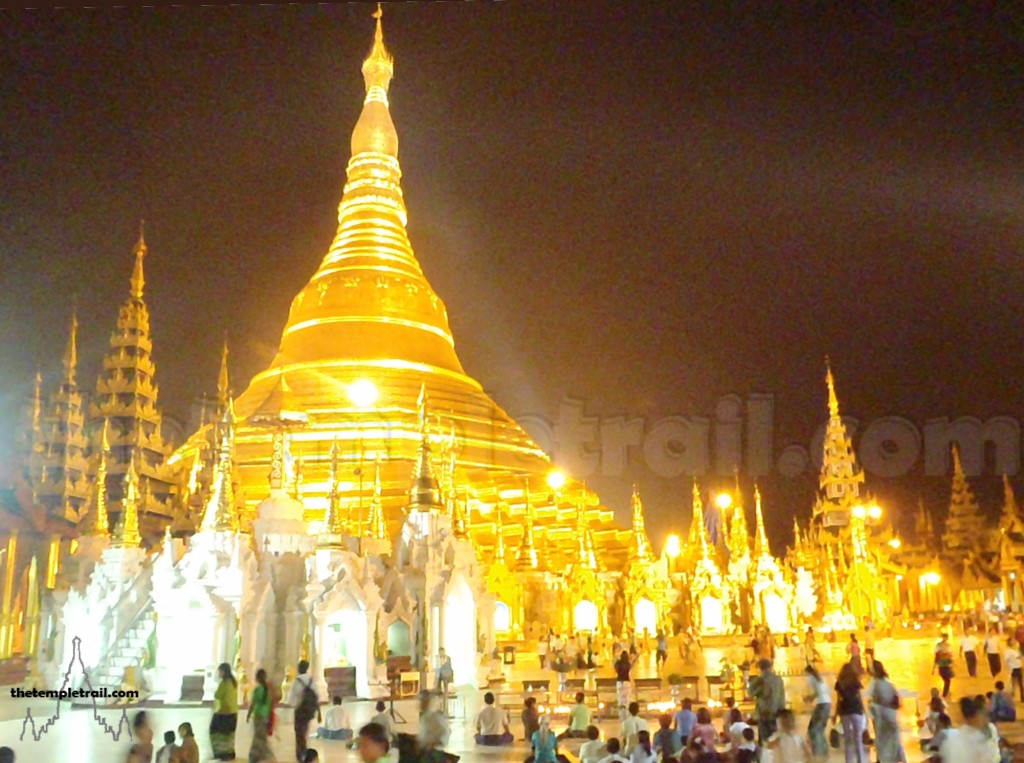
Retreating back down the stairway and out of the temple toward downtown Yangon for a biryani and a milk tea, your head is filled with too much imagery. Luckily, the ticket is for a 24 hour period, so you can come back again on the same ticket that evening and watch as the whole place is transformed into a lit up glowing pedestal of power. The light that comes off the pagoda is enough to radiate out into the heavens. The shrines are all illuminated and the atmosphere becomes even more enchanted. The stupas are suddenly beacons of light and the Buddhas and Nats take on a more superhuman reality. The otherworldly nature of the temple is amplified and infectious. You feel the buzz of the crowds and the vibrations of the zedi as the Nats watch over you re-experiencing Shwedagon in its most mysterious time.
To find out more about the Shwedagon Pagoda, you can visit their official website: http://www.shwedagonpagoda.com/
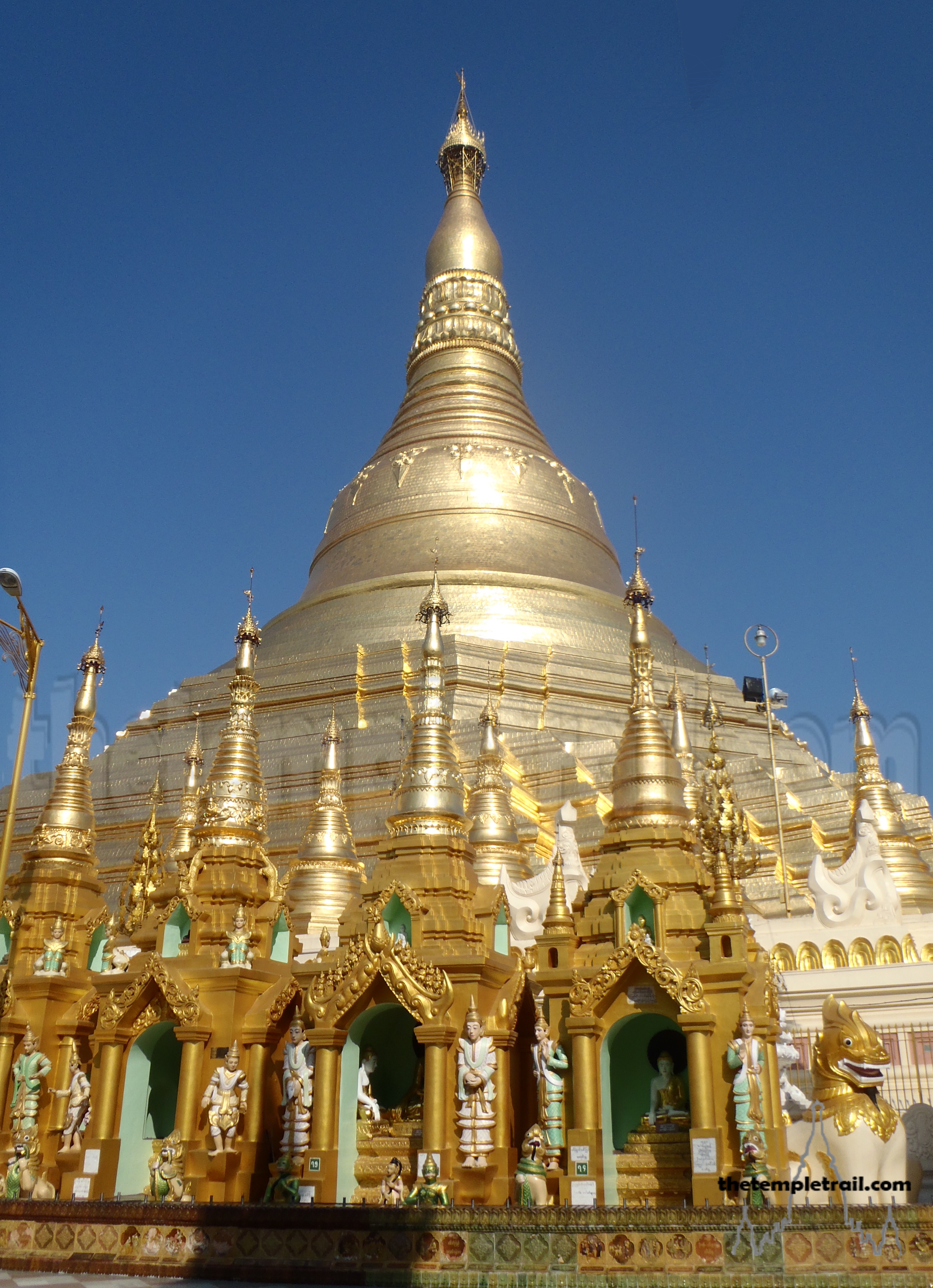
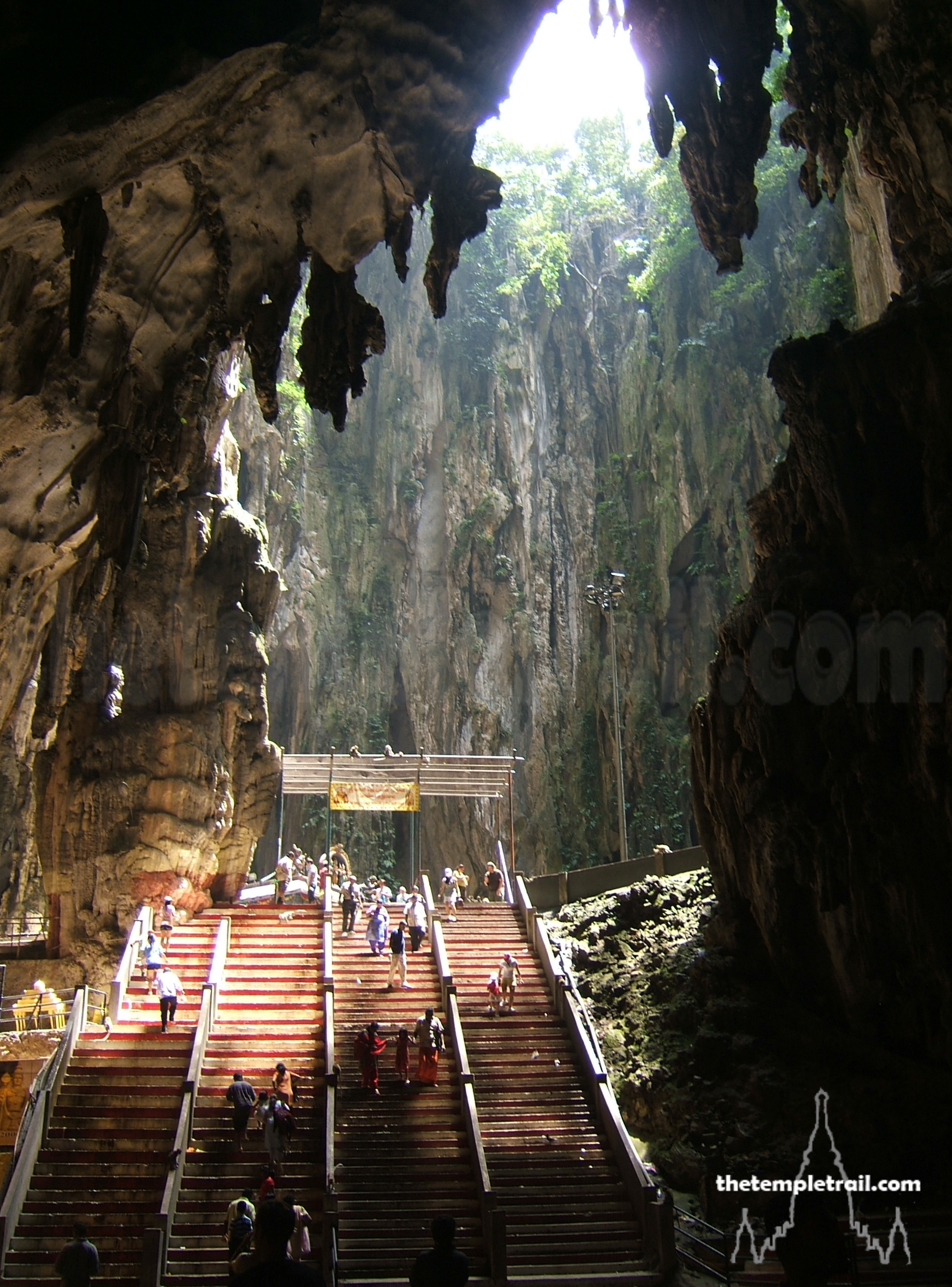 Batu Caves
Batu Caves